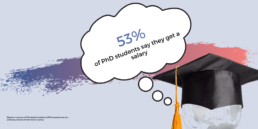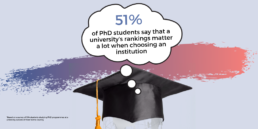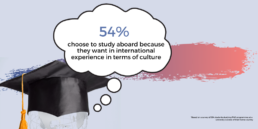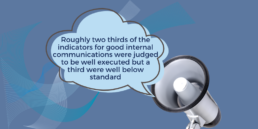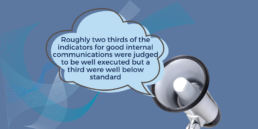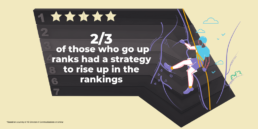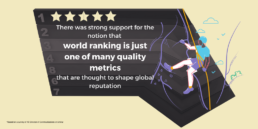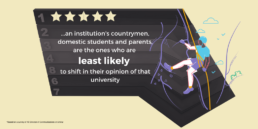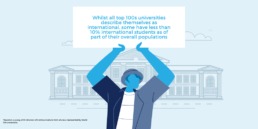Reputation Management: 2014/15
The 2014/15 annual research project returns to the topic of resources and structures for reputation management in the world’s best universities. We first visited this topic in the early days of the World 100 Reputation Network, back in 2008, sending out surveys to the most senior people in communications and marketing, and those managing international offices. Back in 2008, there wasn’t really any social media, ‘internet of things’, blogs or citizen journalism, and rankings were pretty new. How has the passage of time along with innovations in approaches to international relations, the rise of social media and the development of global rankings affected top tier universities’ approaches to prioritising and resourcing reputation management? Have all these innovations and technologies affected the size, style or seniority of teams, and made reputation management more strategic, or better funded? The research reports explore the findings from our surveys of 47 directors of communications and marketing and 22 international directors in world-class global universities spanning 18 countries. Both qualitative and quantitative methods were used, with the research consisting of recorded video interviews with senior Directors from top global universities, qualitative interviews with senior directors on international, marketing and communications to form a series of case studies, and online surveys for the same groups to share their views. The first main report includes the finding from surveying Directors of Communications and Marketing, whilst the second report focuses on the surveying of Directors of International, with reference to the first benchmarking of these directors’ roles back in 2008 throughout. The final version of the reports from the research, Reputation Management: Priorities, structures and resources in world-class universities, were published in February 2016. Members of the W100 Network can access the reports, which include one summary and two main reports, from the news and resources page, plus those involved in the research can also download their individual reports. Available to Members Only Nothing found. The World 100 Reputation Network is a group of the best universities in the world, delivering research that enhances reputation and offering leaders the chance to develop their own careers on a global stage. Members benefit from events and study tours, training, monthly media monitoring, and unique reputation research to provide institutional advantage.Senior Directors were asked about:
As reputation management grows in importance, so does influence
Research Downloads:
Become a Member
PhD Choice Factors: 2013/14
The project set out to consider the extent to which international PhD students valued reputation, and how reputation figured in their destinational choice for a PhD, with a particular desire to better inform those responsible for university communications, marketing and leadership. With support from the World 100 Reputation Network members for the interviews, and the British Council in Japan and FindaDegree.com in circulating the surveys, the research took place in 2014. With over 100 student interviews, and 600 respondents to an online survey, we are able to construct some strong insights into the behaviours and motivations of top academic students, and their perception of and attitudes towards reputation. For the qualitative aspect of the research, we interviewed over 100 PhD students for an hour each, in leading world-class universities, exploring how they defined reputation from a PhD student perspective – both conceptually and in terms of value to them in their current context. Exercises were used to isolate the role of reputation in their choice and to examine at what level reputation is relevant – professor, subject, research field, programme, university, research team, sponsor or funders etc. We also looked at the relationship between ranking status and perceived reputation, which was particularly interesting after our work with academics in 2011/12 showed the academics were keen only to move to top World 100 universities, and always saw their own university as more reputable than rankings suggested. We were keen to see whether students from different continents or countries behaved differently towards reputational indicators. Finally, we were keen to see whether students could understand brand, and whether that was the same as reputation for them. All of these questions clearly have implications for recruitment and reputational communications management directed at potential PhD students in world-class universities. A survey of near identical questions was also distributed to PhD students to explore the issues quantitatively. This is written up as a separate report, but references are made to the findings where relevant The final version of the reports from the research, PhD Choice Factors: How international PhD Students choose top universities and interpret reputation and rankings, were published in November 2014. Members of the W100 Network can access the full reports from the news and resources page, plus those involved in the research can also download their individual reports. Available to Members Only Nothing found. The World 100 Reputation Network is a group of the best universities in the world, delivering research that enhances reputation and offering leaders the chance to develop their own careers on a global stage. Members benefit from events and study tours, training, monthly media monitoring, and unique reputation research to provide institutional advantage.The project set out to discover:
When considering a university, its reputation is a key driver of choice for PhD students
Research Downloads:
Become a Member
Choice Factors in International Academic Job Change: 2011/12
The 2011/12 annual research project set out to investigate the most important factors in international academic job change and the role of reputation in this process. Academics move to join a university for a number of motivations and many factors play a part in crystallising their choice of where to work. Salary, facilities, freedom of expression, the preferences of partners and family, language, legal limitations (e.g. visas), are all considered, but the hypothesis is that reputational factors (essentially, prestige perceptions) play a dominant part. The question is, how important is reputation in the job decision process? Reputation may come into play at the level of country or region, University brand, department, institute, research teams and most likely, the standing of the lead academic. We interviewed 51 academics in 12 world ranked universities. The interviews were mainly conducted as confidential face to face discussions but with one or two telephone interviews where people were unable to meet. There were three times as many men as women. On average they had worked in three different countries. The youngest was 30 and the oldest 67. The most common age group was the 30s, with the 40s and 50s being evenly represented, and the 60s being much less well represented. As well as the general interview, two exercises were also introduced where time allowed. We asked interviewees to rank various factors relating to career progression in order of importance and identify any missing factors that were important when changing jobs, and we also asked them to rank universities according to their own understanding of reputation. Ten universities were chosen because they ranked fairly consistently in the THE and SJT world rankings, and were separated by around 10 points in both. This allowed us to eliminate the ranking differences, and concentrate on comparing rankings and perceptions. We also introduced the academic’s own university, and asked them to place that in the ranking. The final version of the report from the research, Choice Factors in International Academic Job Change, was published in February 2012. Members of the W100 Network can access the report from the news and resources page, and members directly involved in the research can also download their individual reports here. Available to Members Only Nothing found. The World 100 Reputation Network is a group of the best universities in the world, delivering research that enhances reputation and offering leaders the chance to develop their own careers on a global stage. Members benefit from events and study tours, training, monthly media monitoring, and unique reputation research to provide institutional advantage.Academics were interviewed on the following topics:
A key quality metric, global rankings play a role in shaping institutional reputation
Research Downloads:
Become a Member
Internal Communications and Staff Engagement in World-class Universities: 2010/11
The World 100 worked with four UK universities (Bristol, Leicester, Oxford Brookes and Edge Hill) on a project funded by the British Government’s Higher Education Funding Council to develop best practice in internal communications for higher education. The outcome was the HEliX (higher education: leading internal communications) framework – a series of 32 indicators for measuring and benchmarking. The indicators developed for British universities for HEliX were also thought to be important for world-class international universities. As part of the 2010/11 research project, the World 100 adapted the framework’s ‘health check’ into an online survey tool. We invited universities ranked in the World Top 200 to undertake this survey about internal communications and staff engagement in higher education. The questions follow the first management stage of the methodology HEliX (known also as Health Check), and worked by asking respondents to rate their internal communications performance against 35 good practice indicators. Each indicator has evidence points to help the respondent decide the extent to which the indicator is met by his or her institution. Most respondents of the online survey tool were in very senior roles, mainly directors of communications or marketing funcitions, and top universities from eleven countries are represented – Australia, Denmark, Malaysia, Netherlands, Norway, Singapore, Spain, Sweden, Switzerland, UK and USA. Roughly two thirds of the indicators for good internal communications were judged to be well executed (good or outstanding in these universities), but a third were well below standard (judged to be absent or just developing). The indicator given the highest importance score in the research is one where performance was actually rated very poor. The final version of the report from the research, Internal Communications and Staff Engagement in World-class Universities, was published in February 2011. Members of the W100 Network can access the report from the news and resources page, and members directly involved in the research can also download their individual reports here. Available to Members Only Nothing found. The World 100 Reputation Network is a group of the best universities in the world, delivering research that enhances reputation and offering leaders the chance to develop their own careers on a global stage. Members benefit from events and study tours, training, monthly media monitoring, and unique reputation research to provide institutional advantage.HEliX indicators cover:
Despite strong outward facing communications, universities struggle with leadership and strategy
Research Downloads:
Become a Member
Rise and Fall: 2009/10
The second survey-based research project conducted by the World 100, this research project looks at the relationship between changes in rankings and reputation as a whole. It aimed to examine to what extent would a rise or fall impact on other reputational matters, such as success in faculty recruitment, student recruitment, international partnerships or media coverage? The main objectives were to discover how a rise or fall in rank is managed and how it impacts upon the institution’s reputation. The universities involved in the research were those in the top 200 world rankings in the past three years as measured by the two world rankings – the World Academic Rankings of Universities (ARWU), conducted by Shanghai Jiao Tong University and launched in 2003, or the World University Rankings, conducted by The Times Higher Education (THE) and partner QS in 2004. The rankings use different methodologies and metrics with the main difference being that the THE attempts to measure reputation, as well as statistical data, whereas the SJT just looks at statistical data. In total, 268 institutions were eligible to take part. The survey launched in late 2009 and sought to gather the opinions of leaders (VC, President etc.), directors of communications/external relations and international directors (or similarly named equivalent – e.g. PVC for international relations) of these top global universities. There were 49 valid responses to the survey. Of those who chose to describe their role, the majority were Directors of Communications, or similar, followed by academic leaders. The final version of the report from the research, Rise and Fall: Managing reputation associated with significant world ranking change, was published in July 2010. Members of the W100 Network can access the report from the news and resources page. Available to Members Only Nothing found. The World 100 Reputation Network is a group of the best universities in the world, delivering research that enhances reputation and offering leaders the chance to develop their own careers on a global stage. Members benefit from events and study tours, training, monthly media monitoring, and unique reputation research to provide institutional advantage.Senior university leaders were asked:
A key quality metric, global rankings play a role in shaping institutional reputation
Research Downloads:
Become a Member
Website Best Practice for World-Class Universities: 2008/09
For our 2008/09 research project, we reviewed the online profiles of all 137 of the universities ranked in the world top 100 by either the THE or ARWU global rankings to benchmark website best practice in higher education. The analysis of each university website involved 22 key factors and the report was arranged according to these factors. A more recent online brand review of university websites was conducted as part of the 2017/18 annual research project – Brand Snapshot: Measuring online brand strength in world-class universities. The research involved the top 50 universities in world in all four main global rankings, plus W100 members and nominated peers.
Of the 137 universities, only 28 institutions across the sample were judged as having the wow factor and struggled to achieve a rating of exemplary, or even good, in terms of structure and navigation. The final reports from the research, Website Best Practice, were published in November 2008. 2008/09 members received a bespoke report, in addition to the main project report, comparing their sites and brand presence with four agreed world-class competitors. We took an intensive look at the five websites in each case to see how the member stood up against rivals, comparators or benchmarked institutions. The analysis was arranged according to the 22 factors in the main report, but allowed for side by side analysis. The final reports are available for 2008/09 members of the W100 Network via news and resources page. Available to Members Only Nothing found. The World 100 Reputation Network is a group of the best universities in the world, delivering research that enhances reputation and offering leaders the chance to develop their own careers on a global stage. Members benefit from events and study tours, training, monthly media monitoring, and unique reputation research to provide institutional advantage.Outstanding University websites were analysed and presented, with interesting, unusual, notable, or excellent examples highlighted. The screen shots were grouped by:
We covered 22 key areas in the analysis:
No wow factor - universitiy websites struggle to stand out
Further World 100 Research
Research Downloads:
Become a Member
Structures, Strategies and Resources for Reputational Advancement: 2008/09
The 2008/09 research project undertaken by the World 100 scoped the reputation and communications processes, including resources, strategies and structures, of top global universities for reputational advancement. Directors of communications, international and heads of the 137 universities in either of the two university world league tables (The World University Rankings, published and compiled by Times Higher Education and QS, and the SJT World Academic Rankings, produced by Shanghai Jiao Tong University’s Institute of Higher Education) were invited to take part in a survey. A total of 70 unique universities responded, with 95 directors responding in total. We believe it is the first survey of its kind to scope the reputation and communications processes of World 100 universities. 40% of all directors of communications (or nearest role) and 29% of international directors responded – an exceedingly high response rate to an international survey with reputational issues at its core. The research shows that communications and international relations are both important and increasing areas of international activity as top universities seek to make a greater mark on the international stage. Nearly every university has objectives to increase international student and staff numbers and move up in the world league tables. However, there appears to be a disconnect between the activities of the Communications Team and those of the International Relations team, with strategies and plans less likely to be integrated. The final version of the report from the research, Structures, Strategies and Resources for Reputational Advancement, was published in September 2008. Members of the W100 Network can access the report from the news and resources page, and members directly involved in the research can also download their individual reports there. Available to Members Only Nothing found. The World 100 Reputation Network is a group of the best universities in the world, delivering research that enhances reputation and offering leaders the chance to develop their own careers on a global stage. Members benefit from events and study tours, training, monthly media monitoring, and unique reputation research to provide institutional advantage.The research benchmarks the following:
A key quality metric, global rankings play a role in shaping institutional reputation
Research Downloads:
Become a Member







